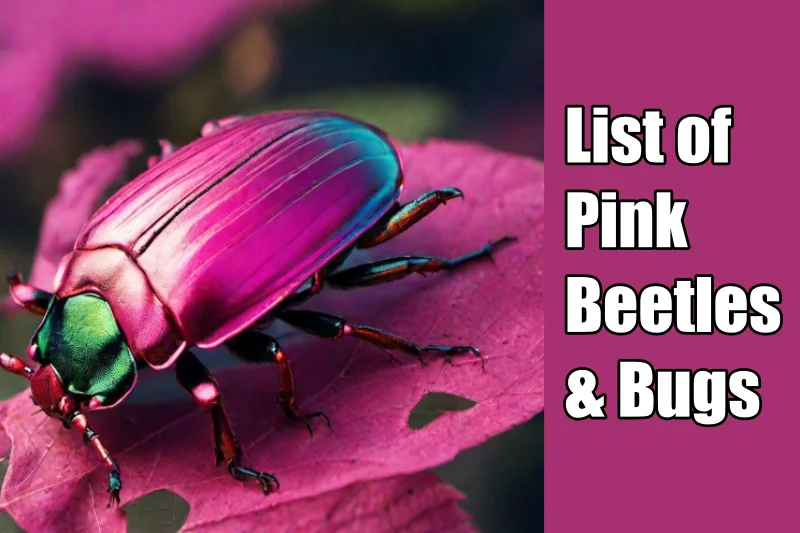We are back with another article on colorful insects. We discussed different insects of different colors. In this article, we will discuss pink beetles and bugs.
These pink beetles and bugs are so uncommon that it’s a rare sight to see them. So let’s continue this colorful journey. Here is a list of 25 enchanting pink beetles and bugs.
Why Are Pink Bugs Uncommon?
Bugs are not usually pink in color. Due to genetic mutations, red pigments get accumulate in their body parts. This unique phenomenon is known as erythism.
This red-pinkish coloration made them stand out in the environment and become vulnerable to predators. This reduction in their population makes them uncommon.
25 Enchanting Pink Beetles & Bugs
1. Elephant Hawk Moth
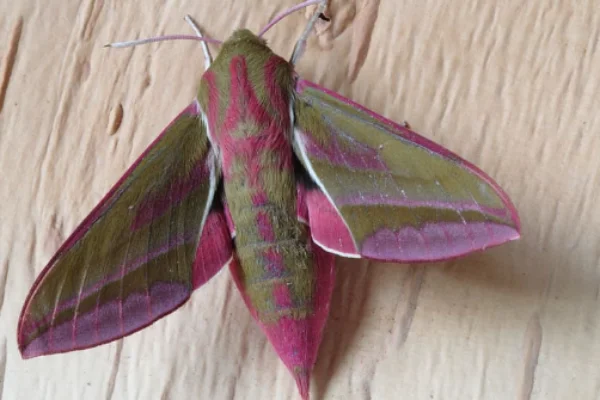
| Scientific name | Deilephila elpenor |
| Size | 60-70 mm |
| Location | Central Europe and In the Palearctic region |
| Habitat | Rough grassland, Heathland, Sand dunes, Hedgerows, Woodland, open countryside, and Even urban gardens |
Elephant Hawk Moth is the common name of Deilephila elpenor. It gets its name from its resemblance to the elephant trunk when stretched.
These moths are olive green in color with beautiful pink markings. Two pink stripes are running along the wings.
You can find this moth in Central Europe and also in the Palearctic. They have well-adapted eyes that make them able to see in dim light. These nocturnal species are in their peak flight from July to September.
2. Orchid mantis

| Scientific name | Hymenopus coronatus |
| Size | 6 to 7 cm |
| Location | Southeast Asia |
| Habitat | Rainforests |
This beautiful creature is commonly known as an orchid mantis or walking flower mantis due to its resemblance to orchid flowers. They are dramatically sexually dimorphic.
Females are double the size of males. Females are 6 to 7 cm long, whereas males are 2 to 5 cm. Apart from their appearance, they are known for their hyperactivity.
Like other insects, they don’t eat anything bigger than their stomach size, which leads to their rupture. If you are looking for an insect pet, then you can count them.
3. Pink spotted lady beetle
| Scientific name | Coleomegilla maculata |
| Size | 5-6 mm |
| Location | New York, Southern Ontario, and Southern New England |
| Habitat | In crops like soybean, alfalfa, sweet corn, etc. |
Coleomegilla maculata is also known as the pink-spotted lady beetle or the twelve-spotted lady beetle. They got this twelve-spotted lady beetle name due to twelve black spots on their pink elytra; they have six on each wing.
These pink beetles are medium in size, with an average length of 5 to 6 mm. Studies show that they usually oviposit on the weed named Ostryaefolia.
They lay eggs around two to five times a year, and each time they lay a clutch of 200–1500 eggs. They prefer to feed on aphids rather than beetle larvae and eggs. Farmers use them as biocontrol agents.
4. The Rosy Maple Moth
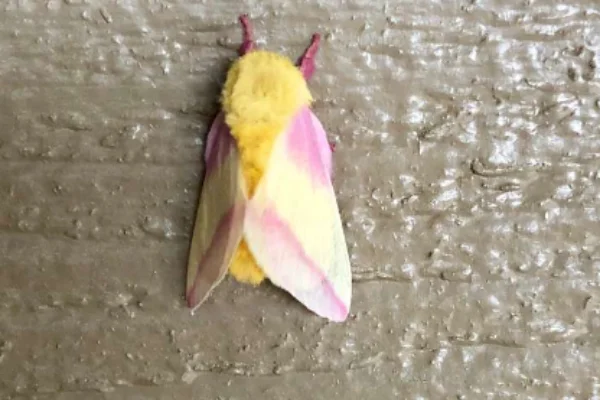
| Scientific name | Dryocampa rubicunda |
| Size | 3.2-5 cm |
| Location | Eastern United States and Canada |
| Habitat | Temperate Deciduous forests, Suburban and urban areas |
These cute moths are the smallest ones in the silk moth family. They have an average wingspan of 3.2–4.4 cm and 3.8–5 cm in females. They are known for their pink and yellow coloration and wooly texture.
You can find these little moths in the Eastern United States and Canada, inhabiting temperate deciduous forests and suburban and urban areas.
Their caterpillar is different from the adults and is known as a green-striped caterpillar because of the green horizontal stripes present all over the body.
5. Leucanella flammans
| Scientific name | Leucanella flammans |
| Size | 10-13 cm |
| Location | Central and South America |
| Habitat | Tropical and Subtropical forests |
They are also known as Giant silkworm moths and belong to the family Saturniidae. They are bright pink with yellow stripes on their wings and have brownish-black spots on their hindwings.
As their name indicates, they are large with an average wingspan of 10-13 cm. This nocturnal moth species is not well known as it is rare in the environment. They are not considered pests and are rare and beautiful sights.
6. Painted meadow grasshopper
| Scientific name | Chimarocephala pacifica |
| Size | 12-25 mm |
| Location | California, Sierra Nevada |
| Habitat | Grassy areas, lowlands |
It is again a member of the family Saturniidae and is also known as a painted meadow grasshopper due to its striking coloration. They are green with pink hindlegs, and laterally, they are also pink in color.
You can find this grasshopper in California and the Sierra Nevada, inhabiting grassy and lowland areas. They are large, with an average body length of 12–25 mm.
Most of their life cycle completes in two to three months. They adapt according to their surrounding environment.
7. Oblong winged katydid
| Scientific name | Amblycorypha oblongifolia |
| Size | 42-52 mm |
| Location | Eastern United States |
| Habitat | Forest, Field, and Garden |
Amblycorypha oblongifolia, or Oblong-winged Katydid, is available in many morph forms, like brown, green, pink, or orange. It’s rare to find them in the wild.
They are widely distributed in the Eastern United States and also widely distributed in Ontario as well.
Their pink morph form is pink in color due to genetic mutations. They are medium-sized, with an average size of 42–52 cm. This species is commonly found on goldenrod flowers.
8. Pink glowworm
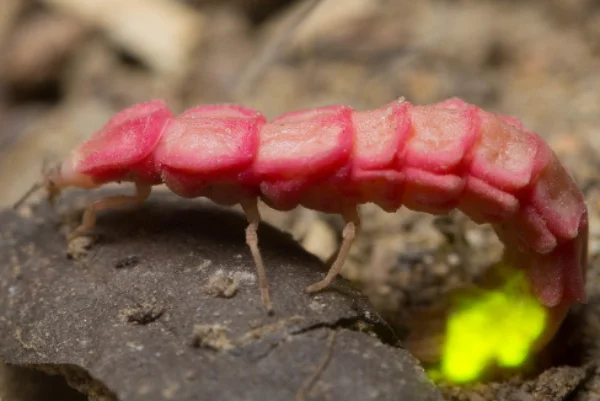
| Scientific name | Microphotus angustus |
| Size | 14 mm |
| Location | California and Mexico |
| Habitat | Woodlands |
California’s Pink Glowworm is the common name of the firefly Microphotus angustus. You can see these distinct creatures in North America, primarily in California and Mexico. Females are different from males in this species.
Females are pink, wingless, and have worm-like segregated bodies. Only females show bioluminescence and glow to attract males for mating. In California, they are a sign of growth and mental clarity.
9. Poplar ladybird

| Scientific name | Oenopia conglobata |
| Size | 3.5-5 mm |
| Location | Europe, North Africa, and Asia |
| Habitat | Bark of trees, Oak and Plum Woodlands |
Oenopia conglobata, or poplar ladybird, gets its common name due to its habitat. Primarily, they overwinter the bark of poplar trees. They are similar to common ladybirds in appearance.
It is small, with an average body size of 3.5 to 5 mm. They are light pink and have eight black spots on their elytra. These popular ladybirds are found in Europe, North America, and Asia. Their larval as well as adult forms mostly prefer aphids to eat.
10. Frog-legged leaf beetle
| Scientific name | Sagra fulgida |
| Size | 25-50 mm |
| Location | Thailand, Indonesia, Malaysia, Vietnam |
| Habitat | Forests |
The frog-legged leaf beetle, or Sagra fulgida, belongs to the family of leaf beetles, Chrysomelidae. Their elytra are metallic pink and have frog-like hindlegs.
They show sexual dimorphism. Females are more worm-like and wingless, whereas males have wings and can fly. They are medium-sized, with a body size of 25–50 mm.
These distinctive beetles inhabit Thailand, Indonesia, Malaysia, and Vietnam, as well as tropical and subtropical regions. They are neither beneficial nor harmful to the plants.
11. Roseate skimmer
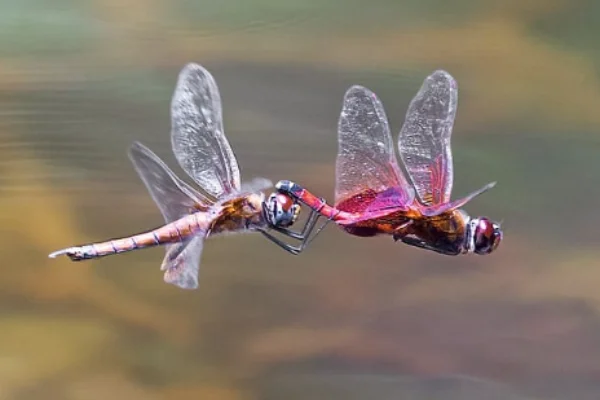
| Scientific name | Orthemis ferruginea |
| Size | 46-55 mm |
| Location | United States to Brazil |
| Habitat | Open or vegetated land |
This rosy pink dragonfly, Roseate skimmer, is widely distributed from the United States to Brazil. They have a purple thorax and a pink abdomen with transparent wings.
The males of this species are aggressive and dislike the invasion of other dragonflies in their territory. They are medium-sized, with an average body size of 46–55 mm and a wingspan of 35–44 mm.
12. Violet Dropwing
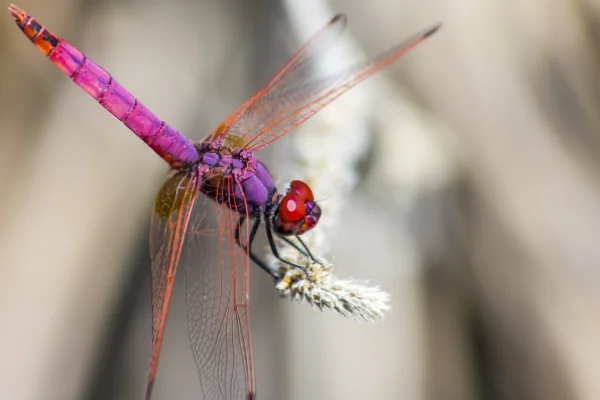
| Scientific name | Trithemis annulata |
| Size | 60 mm |
| Location | Africa, Arabian Peninsula, and Southern Europe |
| Habitat | Semi-arid regions |
As the name indicates, they are violet with the ability to lower their wings after landing. As compared to previous dragonflies, they are large, with an average body size of 60 mm.
One can easily distinguish between males and females. Males are purple-pinkish with red patterns on their wings, whereas females are yellowish-brown.
They are common in Africa, the Arabian Peninsula, and southern Europe. They are adaptive and can adapt to various habitats, including semi-arid regions.
13. Pink-striped oakworm moth
| Scientific name | Anisota virginiensis |
| Size | 4.2-6.6 cm |
| Location | United States and Canada |
| Habitat | Deciduous woodlands and suburbs |
We have another moth species on this list. Anisota virginiensis, or pink striped oak worm moth, is widely distributed in the United States and Canada. Females are large than males and are pinkish-brown bodies with pink stripes on their wings.
Females usually prefer oak trees to lay their eggs. They have characteristic white spots on their forewings, present in both sexes. Their average wingspan is up to 4.2–6.6 cm.
14. Volupial pyrausta moth
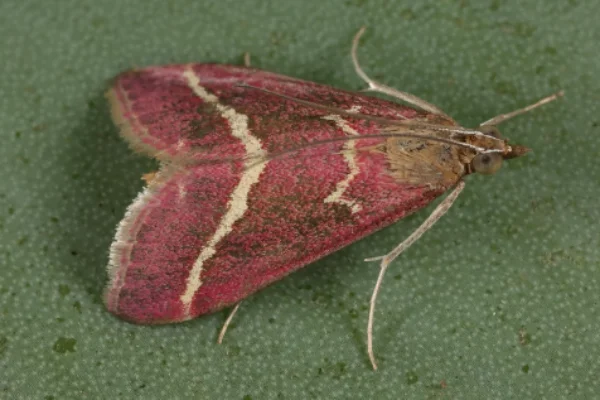
| Scientific name | Pyrausta volupialis |
| Size | 8-10.5 mm |
| Location | Texas,Southern California and San fransico |
| Habitat | Rocky land |
This Crambidae family member, Pyrausta volupialis, is commonly known as the volupial pyrausta moth. Their beautiful, striking appearance is famous among insect enthusiasts. They are pinkish brown with two inclined white stripes and two zigzag stripes.
This nocturnal moth species is active throughout the year. Larvae and adults of this species mostly prefer mint leaves and rosemary to feed on.
They are small, with a wingspan of 8–10.5 mm. One can find them in Texas, Southern California, and San Francisco.
15. Inornate pyrausta moth
Another pink moth, the inornate pyrausta moth, is known for its uniform pink-colored wings. They are small, with an average wingspan of 13 mm. They are commonly found in Arizona, California, Florida, Arkansas, Kansas, Louisiana, Texas, and some other parts as well.
Their larvae are a pest on several plant species. BT cotton is widely used on croplands to control them. Their females are wingless, whereas males have wings and can fly to forage.
16. Sheep moth
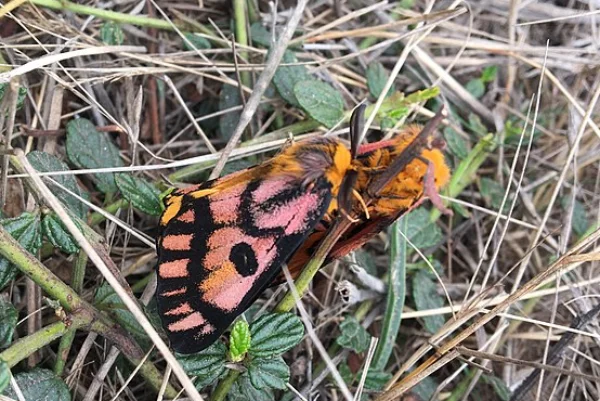
| Scientific name | Hemileuca eglanterina |
| Size | 5.5-8.5 cm |
| Location | Western North America |
| Habitat | Mountain Meadows |
This Western North American native moth is known for its wooly texture and unique coloration. They are small, with an average wingspan of 5.5–8.5 cm.
They are black with pink forewings and yellow hindwings with remarkable black markings. You can find these diurnal moth species in mountain meadows in the summer. According to some research, it is found that adults don’t usually feed.
17. Pink-spotted windmill
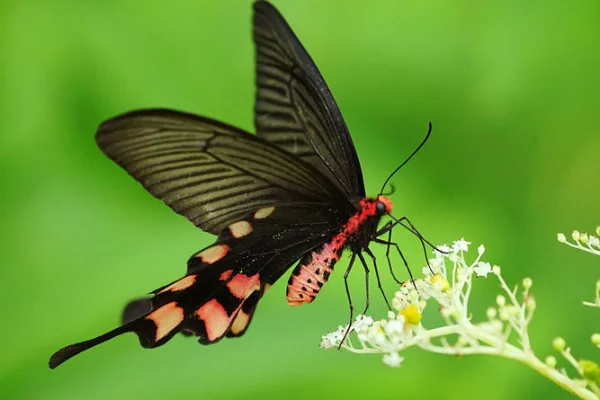
| Scientific name | Byasa impediens |
| Size | 10-11 cm |
| Location | Taiwan |
| Habitat | Tree branches |
Byasa impediens, or pink-spotted windmill, belongs to the family of swallowtails. This butterfly is endemic to Taiwan. They are not as big as other swallowtails and have a wingspan of up to 10–11 cm.
They are black with large pink spots on both forewings and hindwings. Their larvae usually feed on Aristolochia plants and are toxic by nature.
These swallowtails are famous for their apomaestic coloration to warn predators. They are popular among insect collectors due to their striking appearance.
18. Hebes Pink forester

| Scientific name | Euphaedra hebes |
| Size | 2 m |
| Location | West Africa |
| Habitat | Water forests |
Hebes Pink Forester, or Euphaedra hebes, is a butterfly species belonging to the family Nymphalidae. They are widely distributed in West Africa. Let’s talk about their appearance. They are beautiful, with multicolored markings on their wings.
Their hindwings are pink in color with yellow outer linings. They are bivoltine. It means they have two generations per year. One from March to May and the other from July to October. You can easily find them in collections of insect enthusiasts.
19. Pink morph of Boxelder bug

| Scientific name | Boisea trivittata |
| Size | 13 mm |
| Location | North America |
| Habitat | Boxelder tree, Ash tree, Maple tree |
The pink morph of the Boxelder bug, or Boisea trivittata, is a rare and incredible variation of this insect. They are pink in color due to a phenomenon called erythism.
Studies show that this pink morph form is more common in females than males. Due to their coloration, they are prone to predation. That is why they are low in number and a rare sight to see.
20. Broad-headed Sharpshooter Leafhopper
| Scientific name | Oncometopia orbona |
| Size | 1.1-1.3 cm |
| Location | North Carolina, Texas, and Kentucky |
| Habitat | Crops like sunflowers, corn, soybeans, etc. |
The broad-headed sharpshooter leafhopper, or Oncometopia orbona, is known for its ability to jump. Their pink morph is a rare sight to see. If you want to see these amazing yet interesting bugs, then you can find them in North Carolina, Texas, and Kentucky.
They have a characteristically broad yellow head and pink wings with white spots on them. It is known to cause a bacterial disease in grapevines. They mostly prefer sunflowers, corn, soybeans, etc. to feed on.
21. Pink silk moth
| Scientific name | Eudaemonia troglophylla |
| Size | 14 cm |
| Location | Sub Saharan Africa |
| Habitat | Tropical and Subtropical forests |
This moth species is very popular among insect collectors due to its striking appearance and size. They are large, with an average wingspan of up to 14 cm. It is light pink in color with long tails on their hindwings, which make them distinctive yet attractive.
They are commonly found in sub-Saharan Africa, inhabiting tropical and subtropical forests. These nocturnal moths are not very common to see and usually feed on the nectar of flowers in the Apocynaceae family.
22. The Common Windmill

| Scientific name | Byasa polyeuctes |
| Size | 110-140 mm |
| Location | Pakistan, India, Southern China, Nepal, Bhutan, Myanmar, Thailand Vietnam, and Taiwan |
| Habitat | Forests and Woodlands |
The common windmill, or Byasa polyeuctes, is commonly seen in India, Pakistan, Southern China, Nepal, Bhutan, Myanmar, Thailand, etc. They belong to the family of swallowtails, Papilionidae.
It has striking black wings with pink and white markings, and its hindwings are pointed as windmills, which is why it is referred to as the common windmill. They are large, with an average wingspan of 110 to 140 mm. They are very common in the Himalayan range.
23. Rhynchites bacchus
| Scientific name | Rhynchites bacchus |
| Size | 4.5-6.5 mm |
| Location | Spain, Asia, China, North Africa |
| Habitat | No information |
They are small, with an average body size of 4.5–6.5 mm. They are metallic pink, and their whole body is covered with hair. It is very common in long range, like in Spain, Asia, China, and North Africa.
They are a threat to many plant species, like apples, plums, etc. They laid their eggs inside the fruits, and on average, they laid about 250 eggs. Cannibalism is also seen in this species.
24. Arge tiger moth
| Scientific name | Apantesis arge |
| Size | 38–50 mm |
| Location | North America |
| Habitat | Deciduous forests |
As the name implies, they have black tiger stripes on their beautiful pink wings. They usually fly from April to September. They are medium-sized, with an average wingspan of up to 38–50 mm.
It is also bivoltine, like other moths. One can easily find them in North America, from Florida to Mexico, inhabiting deciduous forests.
25. Blushing phantom
| Scientific name | Cithaerias pireta |
| Size | No information |
| Location | Mexico, South America |
| Habitat | lowland evergreen rainforest |
This butterfly is known for its beautiful, transparent wings with eye spots. The blushing phantom is the common name of the butterfly, Cithaerias pireta. You can find this butterfly in the evergreen rainforests of Mexico and South America.
Their transparent wings not only make them attractive but also help them blend in with the environment and avoid predators. When the light strikes them, their transparent wings show a beautiful shade of blue and pink.
Conclusion:
In conclusion, these pink insects are a rare sight to see in nature. They are famous among insect collectors due to their striking and remarkable appearances.
If you ever encounter these insects, you must hold on for a second and appreciate the beauty of these creatures. We will come up with another such article until you must go through this amazing list of pink beetles and bugs.
Also Read:

Being a zoology student I’m always been fascinated toward animals especially insects. I love to do research and learn about different animals. As a writer I want to share my thoughts about nature through my articles. Apart from this you can find me exploring the new places and voice notes.
